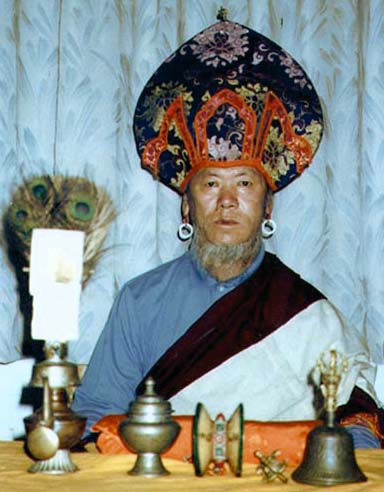
Chökyi Wangchuk Rinpoche
sNgags ’chang bLa dKar Chos kyi dBang phyug Rin po che
This photograph was taken in 1997 and sent to Khandro Déchen and Ngak’chang Rinpoche from Bhutan where Chökyi Wangchuk Rinpoche was residing. Ngak’chang Rinpoche met Chökyi Wangchuk Rinpoche in Nepal in 1990 when he was making a pilgrimage to Yang-lé-shöd to inspect the prospective land for Tsogyel Gé’phel Jong with Gyaltsen Rinpoche. (The land purchase was subsequently sponsored by Sang-ngak-chö-dzong.)
Chökyi Wangchuk Rinpoche noticed Ngak’chang Rinpoche walking with Gyaltsen Rinpoche at a distance and came up immediately to introduce himself. His attention had been drawn by Ngak’chang Rinpoche’s white skirt, and he felt moved to establish contact.
Chökyi Wangchuk Rinpoche
said:
It is now so rare to meet a Lama wearing the gö-kar chang-lo – and upholding the
Dzogchen teachings of the Nyingma
tradition. I am so joyful to meet with you here in this sacred place.
Ngak’chang Rinpoche and Chökyi Wangchuk Rinpoche arranged to meet in Thamel where Ngak’chang Rinpoche was living at the time, and soon became close friends. Chökyi Wangchuk Rinpoche presented Ngak’chang Rinpoche with a pair of dung-kyi na-gan (dung kyi rNa rGan – conch earrings) and a wonderful bumpa which had been passed through his family for generations.
Chökyi Wangchuk Rinpoche is a Ngakpa Lama and an incarnation from the family clan of gTértön Ratna Lingpa (gTer sTon chos rGyal rat na gLing pa, 1403-1478) and teaches in Bhutan, Taiwan, and Bylakuppe (Southern India). Chögyal Ratna Lingpa was one of the nine major Lingpas (gTértöns) of Tibet. He discovered twenty-five gTérmas. He was an incarnation of Langdro Lotsava (lang gro lo tsa ba), also called Ratna Zhigpo Drö’dül Lingpa (rat na zhig po ’dro ’dul gLing pa).
The Lingpa-gyèd (gLing pa dGu – Nine Lingpas) were Sang-gyé Lingpa (Sangs rGyas gLing pa, 1340-1396), Dorje Lingpa (rDo rJe gLing pa, 1346-1405), Rinchen Lingpa (gTer sTon rin chen gLing pa,1295-1375), Padma Lingpa (Pad ma gLing pa, 1450-1521), Ratna Lingpa (Rat na gLing pa,1403-1478), Traktung Düd’jom Lingpa (khrag ’thung bBud ’joms gLing pa, 1835-1903), gTértön Düd’jom Lingpa Jig’drèl Yeshé Dorje (gTer sTon bDud ’joms gLing pa ’jigs bral ye shes rDo rJe,1904-1989); Do-ngag Lingpa (pad ma gar dBang ’od gsal mdo sNgags gLing pa, 1910-1991) and Tennyi Lingpa (bsTan gNyis gLing pa pad ma tshe dBang rGyal po, 1480-1535).
In this photograph, Chökyi Wangchuk Rinpoche wears conch earrings—similar to the ones he presented to Ngak’chang Rinpoche—and the red and white shawl of the gö-kar chang-lo’i dé. The predominantly blue hat with red edging is characteristic of Chökyi Wangchuk Rinpoche’s Nyingma family lineage.
In response to their discussion concerning the plight of the gö-kar chang-lo’i dé in the East, Ngak’chang Chökyi Wangchuk Rinpoche provided Ngak’chang Rinpoche and Khandro Déchen with a quotation from the Kuntuzangpo Ralpa Nakpo mDo (Kun tu bZang po ral pa nag po’i mDo) – the Primordial Black Braids Sutra which states:
In the degenerate era,
When red-faced beasts have ruined the Vajrayana,
Those with white skirts will benefit sentient beings.
Thence arises the need for long-haired practitioners.
A carefree body donning a white skirt and head adorned with braids,
This is the sky-like appearance of the trülku.
Carefree long uncut hair,
This is the sky-like appearance of the long-ku.
Carefree view of pure Mind,
This is the chö-ku.
Achieving the three spheres of being within oneself,
This is the practice of Dzogchen.
On receiving this text
Ngak’chang Rinpoche and Khandro Déchen
wrote in a Vajra
Letter:
What choice have we now but to manifest the gö-kar chang-lo
in the world for the benefit
of everyone and everything, everywhere? What choice have we but to protect the
glorious rôle of the vajra master as the heart of all Vajrayana teachings?
What choice have we but to
speak out when red-faced
beasts insult the Mahasiddhas of the 20th
century who have so kindly given us the heart-blood
of
their incendiary wisdom.
Although we are not adequate
examples of white skirted long-haired
practitioners – we can at least speak out against the rhetoric of the red-faced
beasts who are attempting to ruin the Vajrayana.
